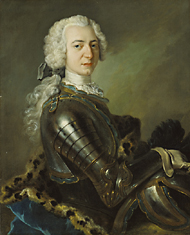 |
 |
| |
 Male Leopard Male Leopard, Jean-Baptiste Oudry, 1741 Staatliches Museum Schwerin |
This exhibition is the result of an international collaboration of conservators, curators, and art historians. The project was born in Schwerin, Germany, in 2001, upon the reemergence of two enormous canvases by French artist Jean-Baptiste Oudry (1686–1755)—one depicting a lion, the other a rhinoceros. These paintings, not seen in public for more than 150 years, have been treated in the Getty Museum's Conservation Department over the past several years. Oudry's Painted Menagerie reunites them with a suite of other life-size portraits of exotic animals painted by Oudry and presents a selection of Oudry's drawings as well as contemporary decorative arts.
Learn more about the conservation of Lion and Rhinoceros.
Follow the four-year conservation process of Rhinoceros in this video, which features footage from a 30-minute documentary by William Friedkin. (4:48)
Oudry and the Royal Menagerie
Jean-Baptiste Oudry was one of the finest painters of animals and the hunt in 18th-century Europe, and he employed his prodigious talents and illustrative power to produce life-size paintings of star specimens from the menagerie, or zoo, of French king Louis XV. Never intended as an encyclopedic zoo, the Versailles menagerie was compiled through royal commission and diplomatic gifts. Exotic animals were imported on merchant ships along with sugar, coffee, and indigo, and were intimately connected with colonialism and the luxury trade. Oudry painted these animals as individuals. He used portrait conventions such as theatrical poses, dramatic light effects, imaginary landscape backdrops, and sensual color to give his paintings great drama.
Oudry's menagerie was sold in 1750 to Christian Ludwig II (1683–1756), the duke of Mecklenburg-Schwerin in northeastern Germany, who was Oudry's primary patron. His son, Crown Prince Friedrich (left), served as the primary agent between Oudry and the duke when he acquired the animal portraits in this exhibition.
Oudry as Draftsman
The exhibition also includes a group of Oudry's drawings. Drawing was central to Oudry's artistic work, and he was among the most prolific draftsmen of his generation. First trained as a painter of historical subjects, Oudry learned the traditional method of preparing a composition with drawings, and he continued the practice as he came to specialize in animal, hunt, and still life subjects. Oudry's drawings are diverse in subject and technique; the artist both invented and copied single motifs as well as entire compositions, and he drew in almost every available medium, though the majority of his known drawings were made with black and white chalk.
Exotic Animals in 18th-Century Europe
The third section of the exhibition presents a selection of decorative arts that represent the sociocultural phenomenon of exotic animal celebrity in the 18th century. Many of these objects reflect the intense public curiosity about the "Dutch" rhinoceros Clara, a famous touring rhinoceros depicted in Oudry's monumental painting Rhinoceros. Clara's 17-year tour through Europe inspired everything from whimsical hairstyles "à la rhinocéros" to horse harnesses. The exhibition includes examples of "Clara-mania" and "rhino-mania" in small marble, bronze, and porcelain sculptures, clock cases, prints, coins, and more.
Oudry's animal paintings will continue on to the Museum of Fine Arts Houston, October 7, 2007–January 6, 2008.
This exhibition is organized by the J. Paul Getty Museum in association with the Staatliches Museum Schwerin and the Museum of Fine Arts, Houston.
 |
The Los Angeles presentation is sponsored by WACHOVIA. |
The Paintings Conservation Council of the J. Paul Getty Museum and the Friends of Heritage Preservation provided generous support for the treatment of Rhinoceros and Lion; Feldtmann Kulturell funded treatment of Demoiselle Crane, Toucan, and Tufted Crane; and FAMA Kunststiftung funded treatment of Bustard and Guinea Hen.
|
 |
|


